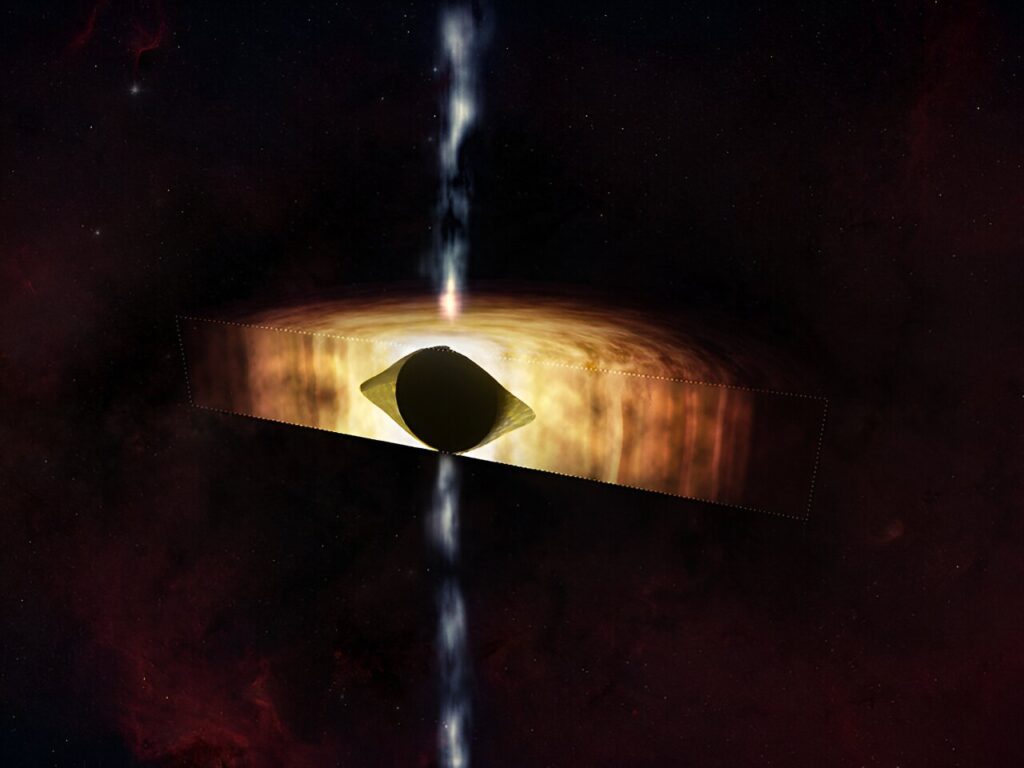Astronomers are studying a giant black hole in the centre of our star system. They have measured the rotation speed of this object and predicted that in the future it may begin to eject powerful jets.

What do we know about the Sagittarius A* object?
A supermassive black hole at the centre of the Milky Way is spinning so fast that it is deforming the space-time around it into a shape that may resemble a rugby ball. At least that’s what a new study using data from the Chandra X-ray Observatory and the Very Large Array (VLA) of the Carl G. Jansky National Science Foundation Institute suggests.
Astronomers call this giant black hole, which is located about 26,000 light-years from Earth in the centre of our galaxy, Sagittarius A*. Objects like this have two fundamental properties: mass (how much they weigh) and spin (how fast they rotate). Determining either of these two parameters gives scientists a lot of information about the black hole and how it behaves.
The team of researchers applied a new method that uses X-ray and radio data to determine how fast Sagittarius A* is spinning based on how material moves towards and away from the black hole. They found that the object is rotating at an angular velocity of about 60 revolutions per second, which is about 60% of the maximum possible value based on the fact that matter cannot move faster than the speed of light.
In the past, various astronomers have made several other estimates of Sagittarius A*’s rotation speed using different methods, and the results have ranged from the black hole not rotating at all to it rotating at nearly the maximum speed.
Study of a black hole’s rotation speed
“Our work may help to resolve the question of how fast our galaxy’s supermassive black hole is spinning,” says Ruth Daly of Pennsylvania State University, who is the lead author of the new study. “The results indicate that Sgr A* is spinning very fast, which is interesting and has far-reaching implications.”
Black hole spin can be an important source of energy. Supermassive spinning black holes can create collimated outflows, i.e. narrow beams of matter such as jets, when their rotational energy is drawn out, and this requires at least some matter to be in the vicinity of the black hole.
Due to the limited matter around Sagittarius A*, this black hole has been relatively quiet in recent millennia with relatively weak jets. However, the study shows that this could change if the amount of matter in its vicinity increases.
A black hole may start to erupt
This means that in the future, if the properties of the matter and the strength of the magnetic field near the black hole change, some of the black hole’s enormous spin energy could cause more powerful outflows. This material could come from gas or from the remnants of a star torn apart by gravity if that star roams too close to Sagittarius A*.
The jets fed and collimated by the central black hole of a rotating galaxy can have a profound effect on the gas supply for the entire galaxy, which affects how quickly stars can form. “Fermi bubbles”, which can be seen as X-rays and gamma rays around our Milky Way black hole, show that the black hole was probably active in the past. Measuring the spin of our black hole is an important test of this scenario.
To determine the spin of Sagittarius A*, the authors used an empirically based theoretical method called the “outflow method”, which details the relationship between the spin of a black hole and its mass, the properties of matter near the black hole, and the outflow properties.
Although the black hole is now calm, the work of scientists shows that in the future it will give an incredibly powerful impetus to the surrounding matter. This could happen in a thousand or a million years, or it could happen in our lifetime.
Based on materials of phys.org

